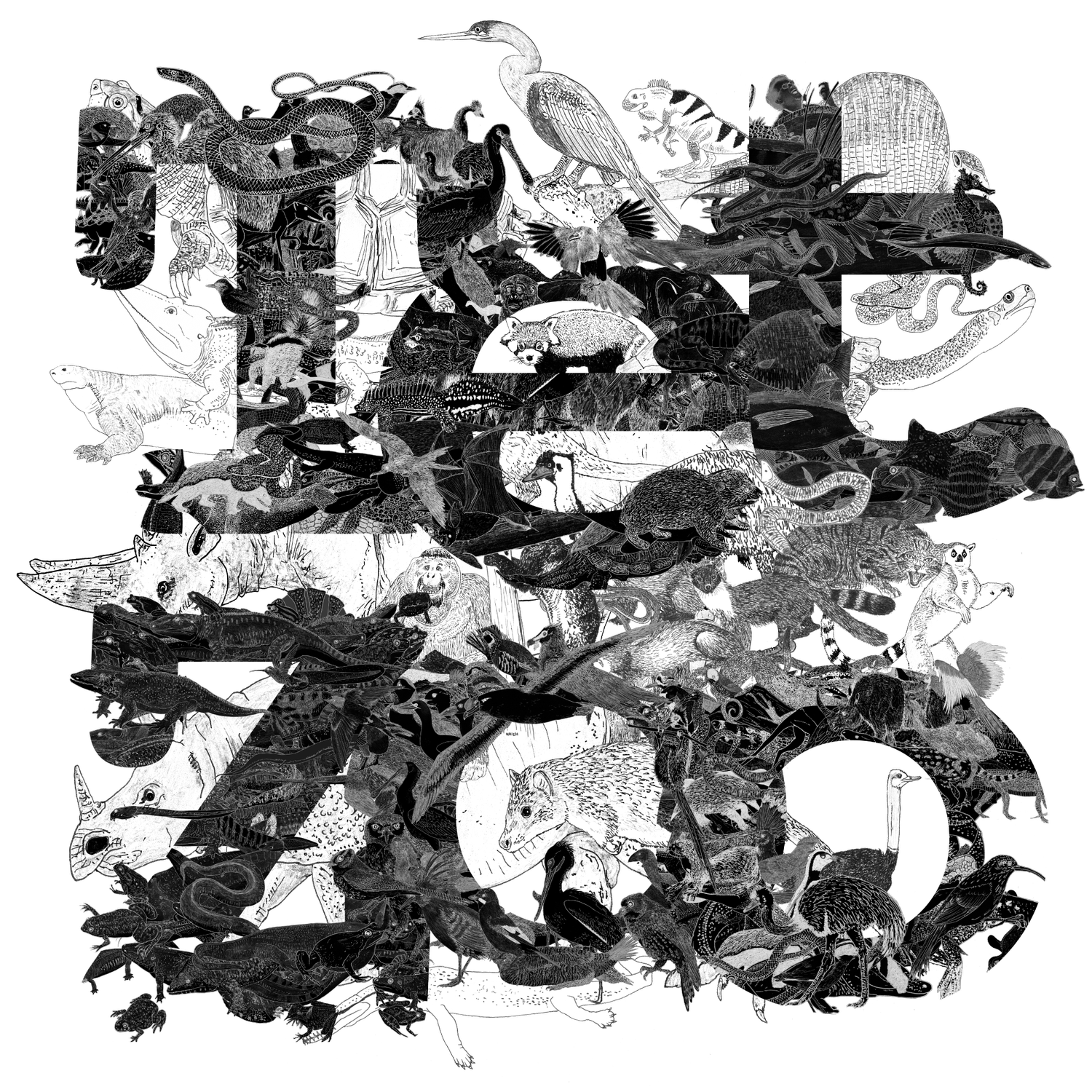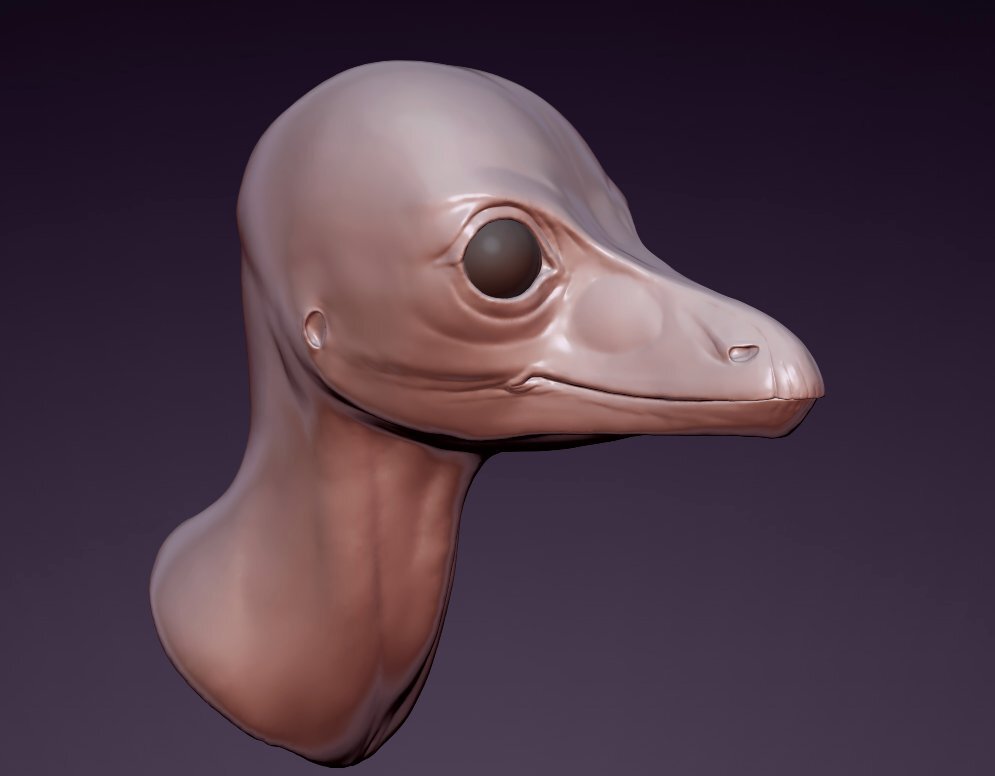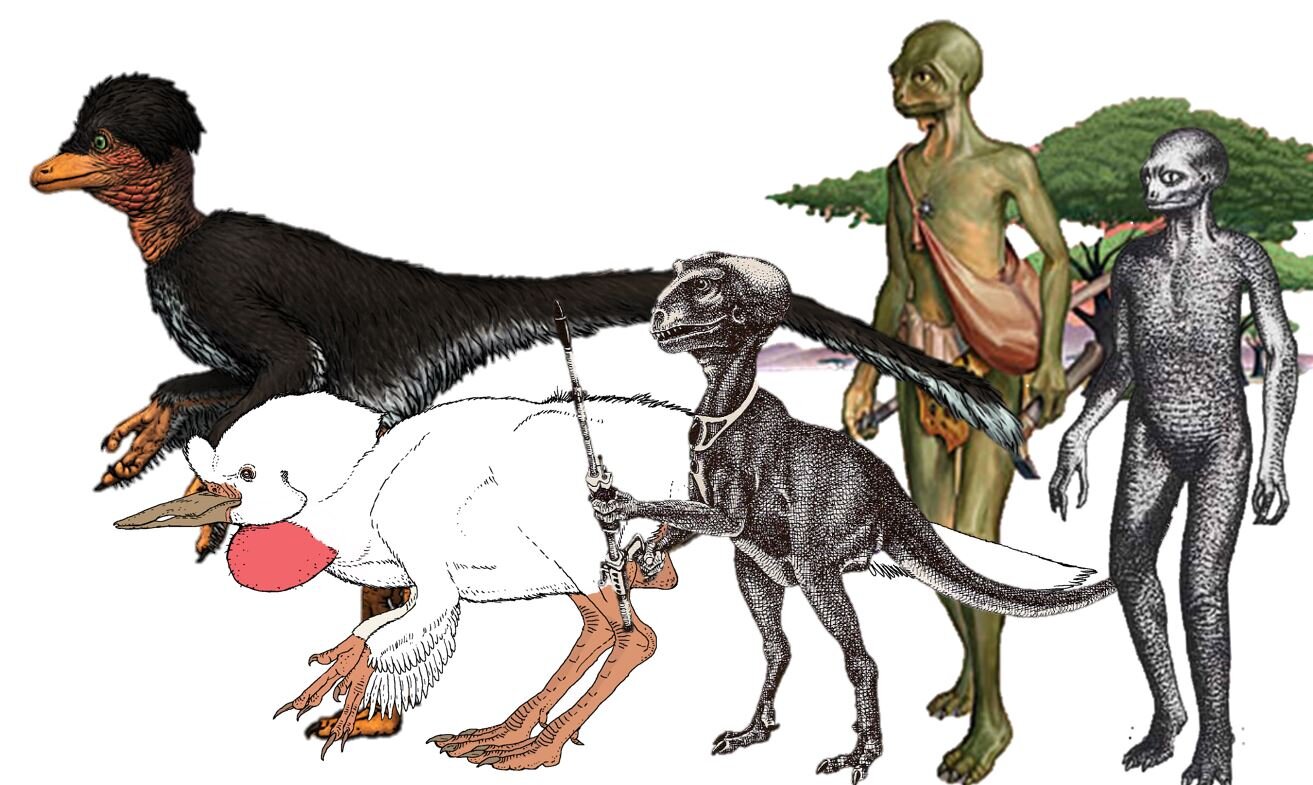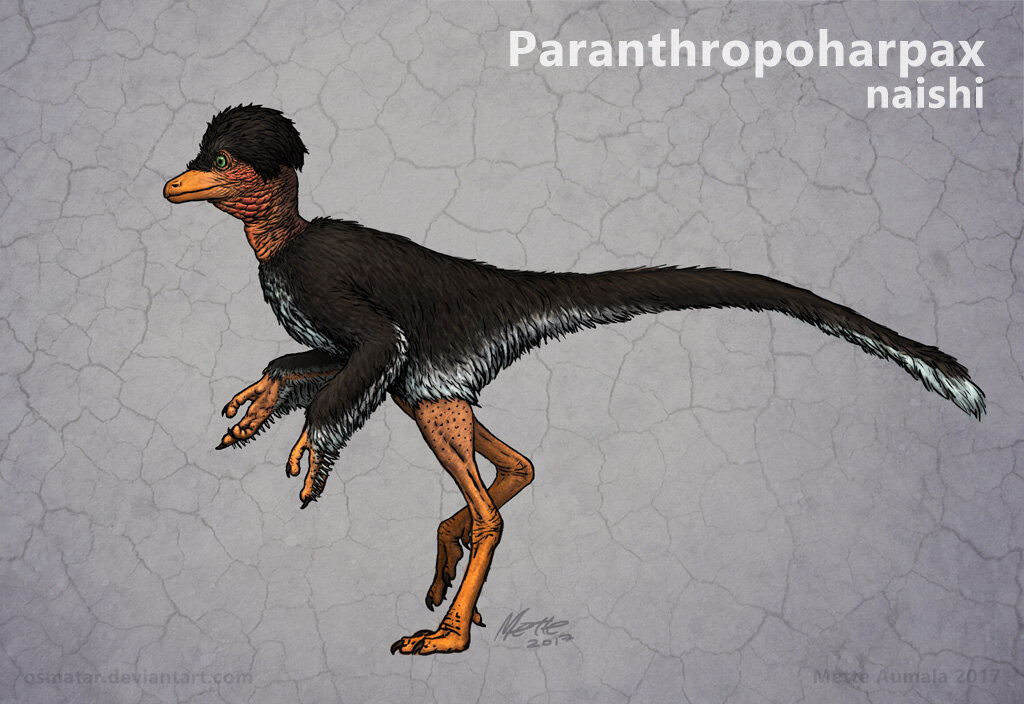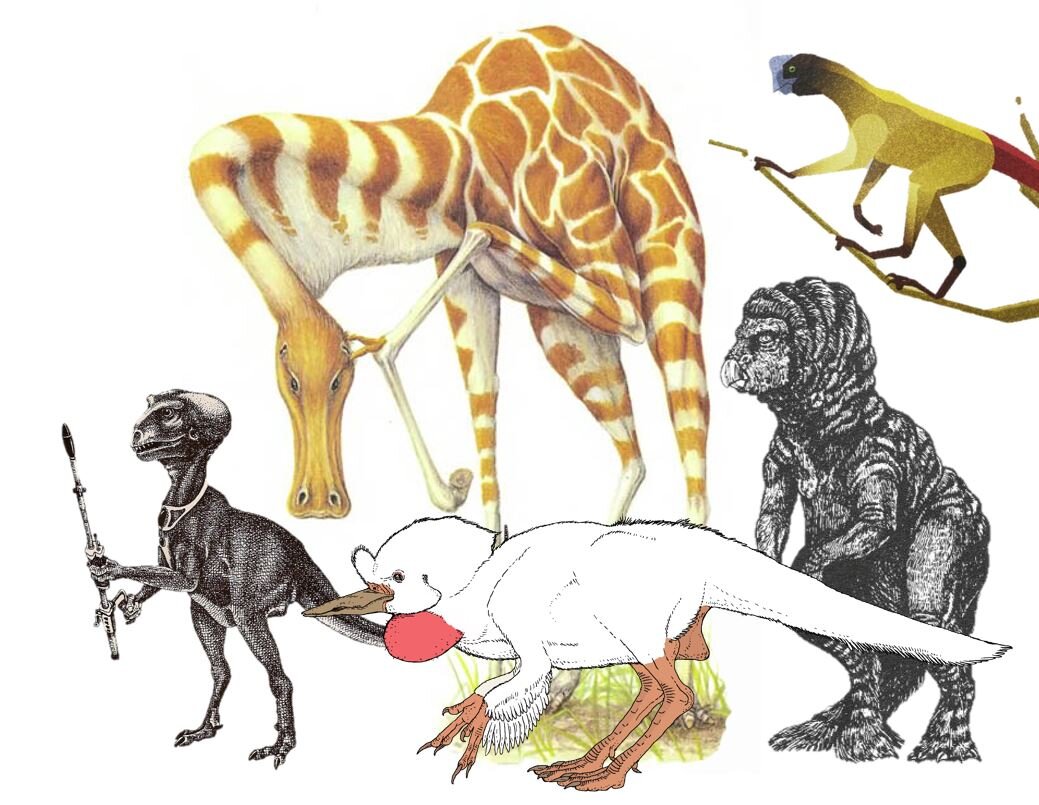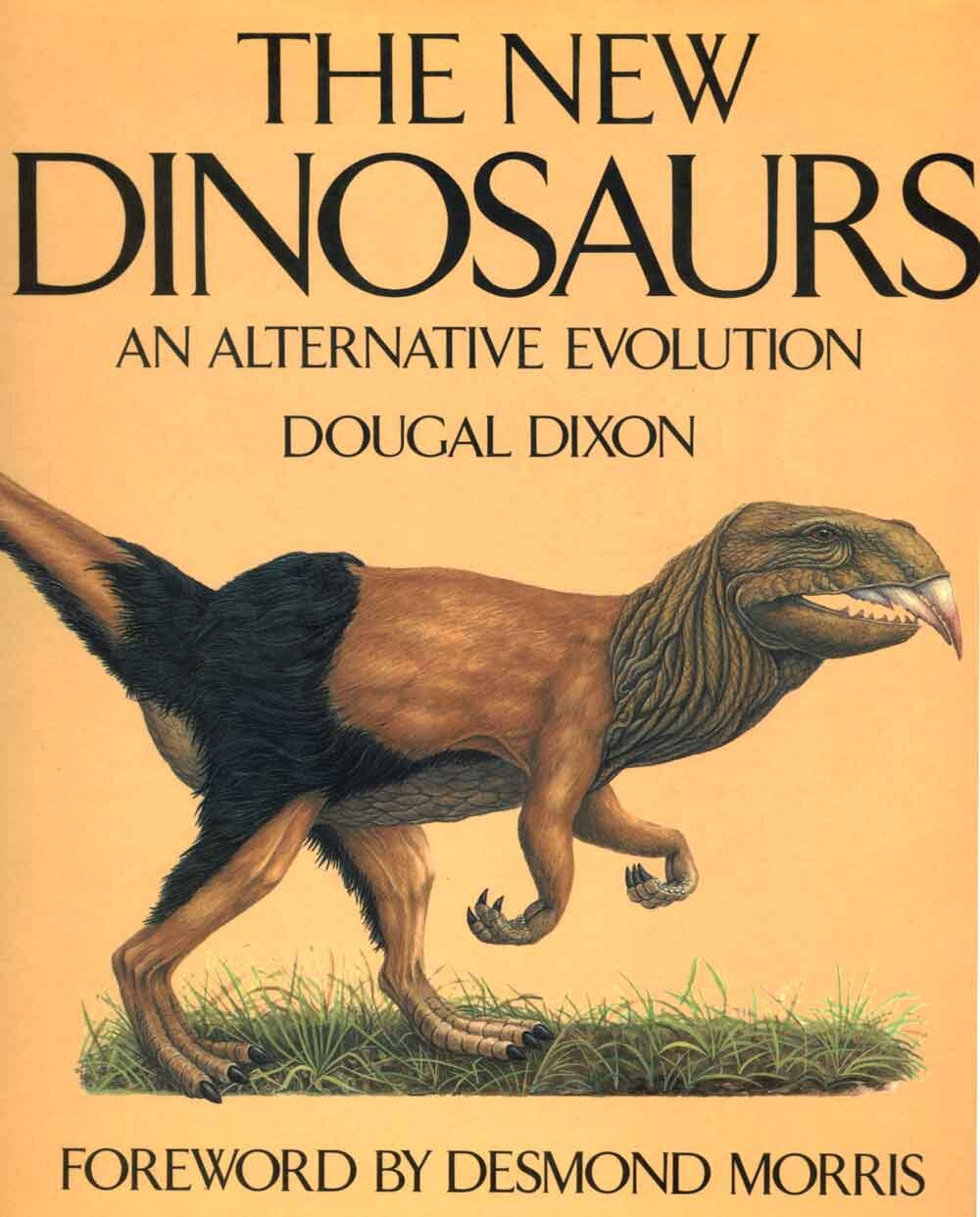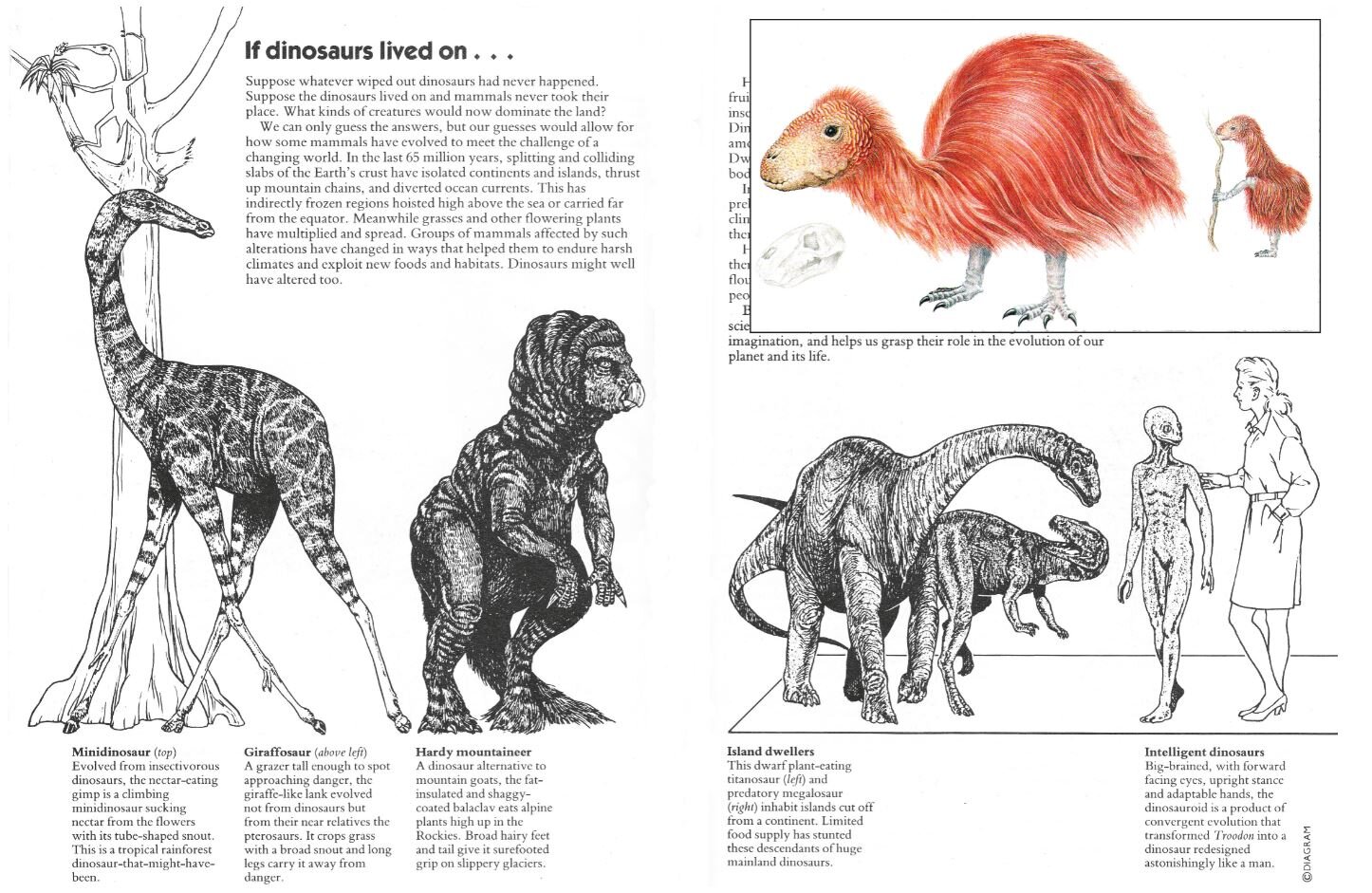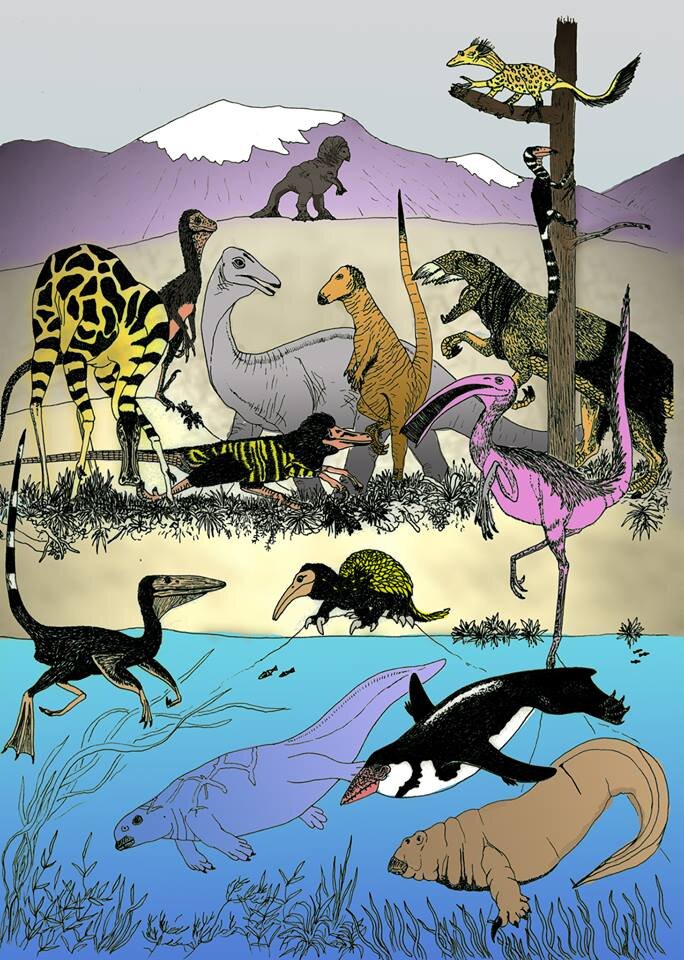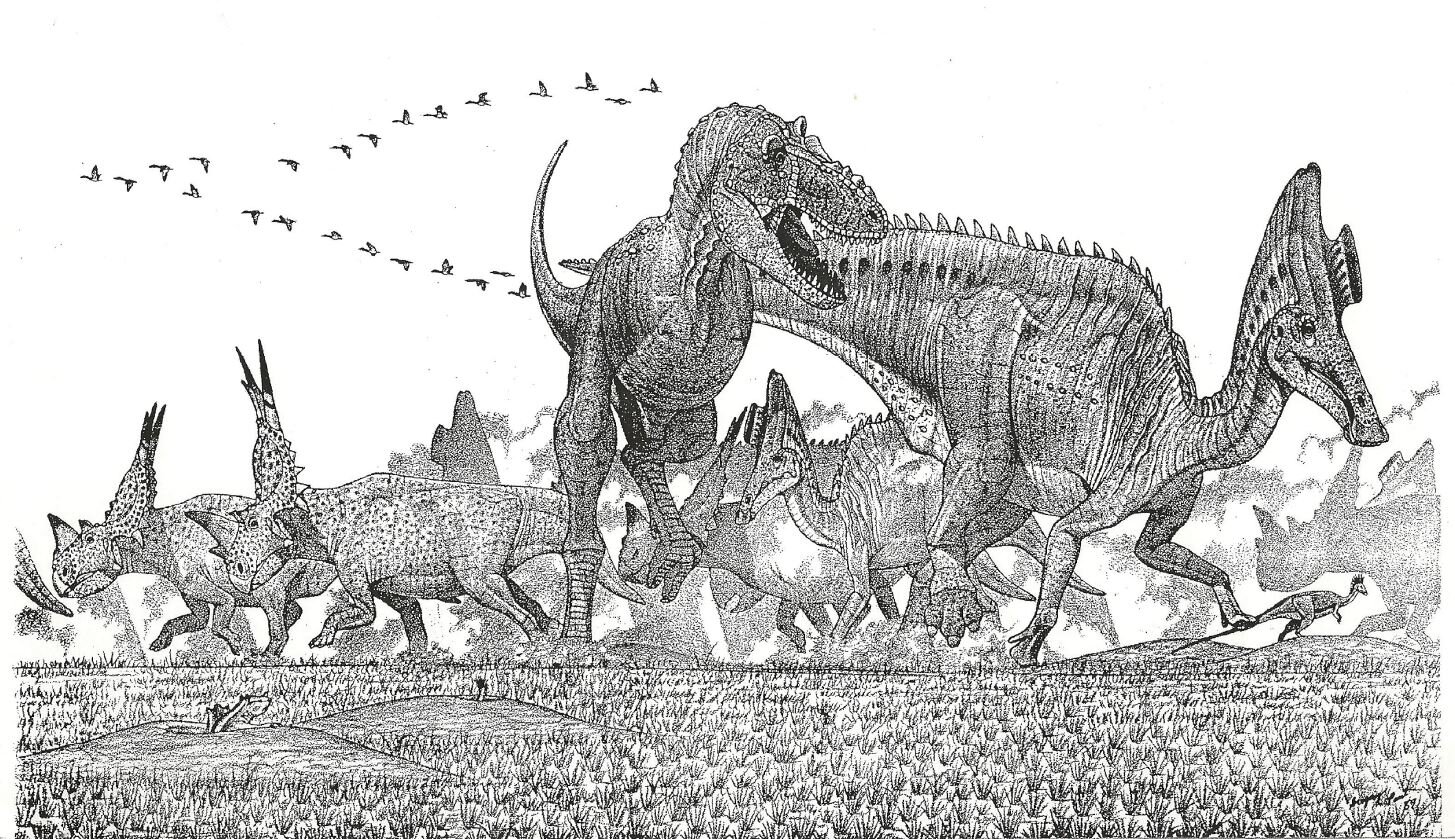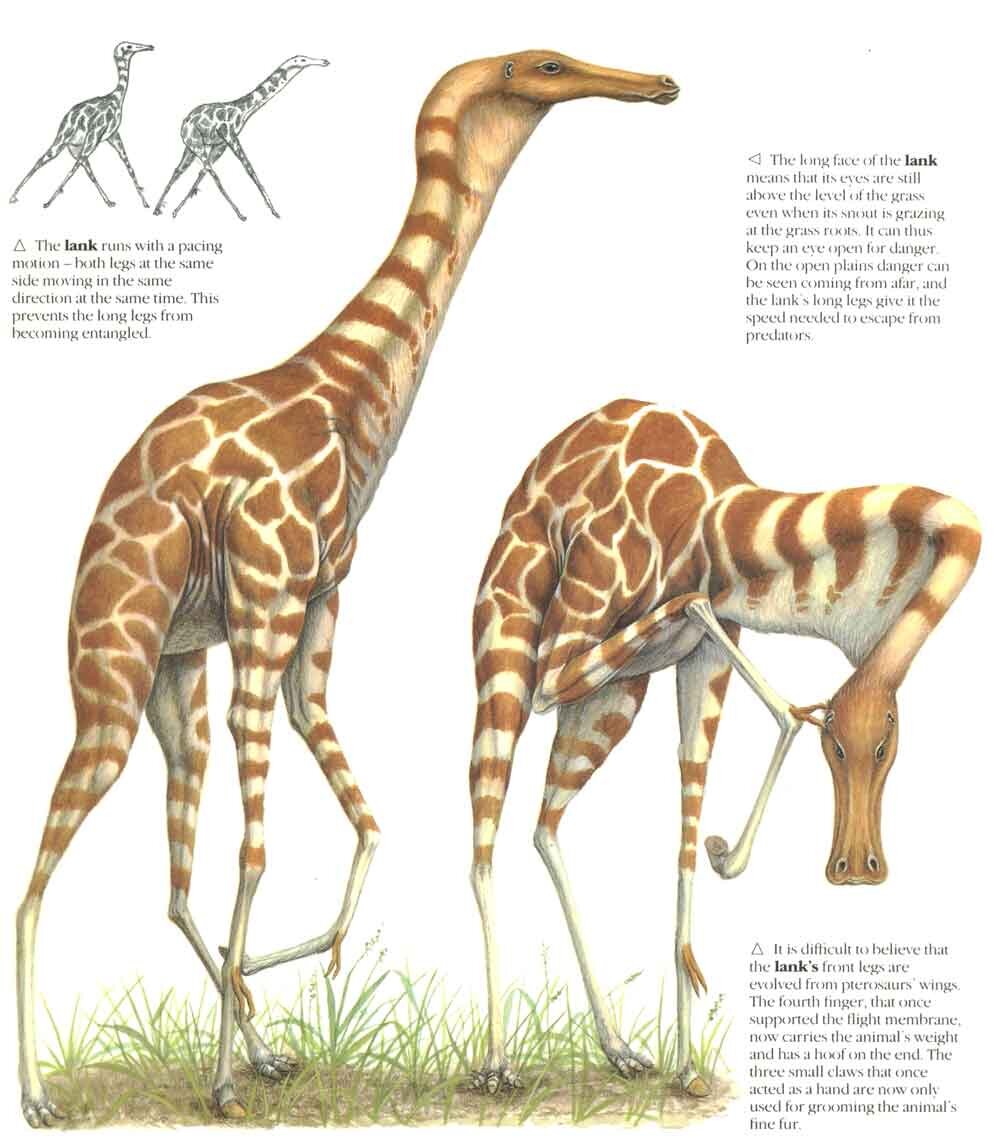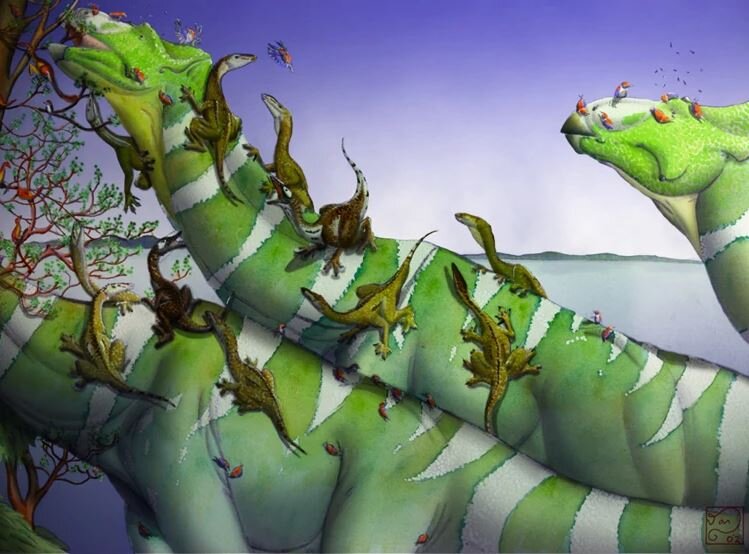Having recently republished an old, classic article on Speculative Zoology – that based around a 2014 interview with After Man creator Dougal Dixon – it seemed appropriate to republish another Tet Zoo classic…
Speculative Zoology and the World of After Man; an Interview With Dougal Dixon
My Own Personal Dinosauroid
The Snouters or Rhinogradentians, a Brief Review
The Netflix Series Alien Worlds
December 2020 saw the release of the Netflix series Alien Worlds, a four-part exploration of imaginary alien life. The series is science-led throughout and incorporates world-class CG creature effects in addition to real world explorations of the various biological and evolutionary phenomena discussed across the episodes. Sophie Okonedo narrates.
Dougal Dixon’s After Man, the Initial Pitch Document
There can’t be many visitors here who are unaware of Dougal Dixon and his 1981 book After Man (Dixon 1981), the work which effectively started the entire Speculative Zoology (or SpecZoo) movement.
Alternative Timeline Dinosaurs, the View From 2019 (Part 3): the Dinosauroid and its Chums
Welcome to another article on alternative timeline dinosaurs.
Caption: what’s this? It’s an unfinished sculpt of the head of Paranthropoharpax, by Mette Aumala. Read on for more. Image: (c) Mette Aumala.
The previous two articles looked at recent and current ideas on those non-bird dinosaurs that might have evolved in alternative timelines where the end-Cretaceous extinction event never happened, and where the modern world is occupied by the descendants of groups that otherwise went extinct about 66 million years ago. You can see those articles here and here. And the most recent of those two articles looked at the ‘would there be humans anyway?’ argument, always a mainstay of alternative timeline dinosaur discussion.
Caption: a whole bunch of dinosauroids, variously by (left to right) Mette Aumala, C. M. Kösemen, John McLoughlin, Matt Collins, John Sibbick.
The other big question that everyone asks about post-Cretaceous, alternative timeline dinosaurs is also about the evolution of intelligence, but this time of a non-human sort. If non-bird dinosaurs didn’t go extinct, surely they’d give rise to animals of primate-like, if not human-like, intelligence… right? The ‘intelligent dinosaur’ meme has been covered quite a bit here on TetZoo before (see links below), the problem as always being that my older articles on this subject are today plagued by hosting issues. For this reason I’ve linked below to the wayback machine versions of the articles concerned.
Caption: if you’ve ever opened a post-1980s dinosaur book, chances are high that you’ve seen photos of Dale Russell and Ron Séguin’s troodontid and dinosauroid models. This is the commonest set of images, as reproduced in Russell (1987, 1989) and other sources.
Conversations about big-brained dinosaurs invariably revolve – as well they should – around Dale Russell’s ‘dinosauroid’ of the 1980s, an imaginary humanoid theropod which Russell posited as a possible evolutionary descendant of troodontid theropods had they continued to evolve beyond the end of the Cretaceous. I’m keen to avoid saying too much about the dinosauroid here for fear of repeating content, but it’s worth noting that Russell’s vision of the dinosauroid was more fleshed out and detailed than many assume, and that its anatomy was more complex and nuanced than might first appear (Russell & Séguin 1982). Anyway, please read the older TetZoo articles if you want to dig deeper.
Caption: a rare photo of Dale Russell (at left) and Ron Séguin in the company of the dinosauroid; this photo belongs to the archives of the Canadian Museum of Nature and was shared in September 2019 by Jordan Mallon. Image: (c) CMN.
The dinosauroid’s infamy was and is due to the construction of an amazingly good life-sized model by sculptor Ron Séguin, who collaborated with Russell on the project (Russell & Séguin 1982). I saw the model in person in 1990 when it came to the UK for the Dinosaurs Past & Present exhibition, but failed to take the illegal photos I now so wish I had. You can read about my recollections of that amazing exhibition here (and be sure to read the comments).
Caption: Ely Kish’s dinosauroid models, used as the basis for a large painting which she finished; it remains in storage and has never seen print. These images were shared on Michael Ryan’s blog (here). Images: (c) Michael Ryan.
Séguin’s construction is well known, but a revelation new(ish) to some of us is that the late Ely Kish – another artist who collaborated with Russell (Russell 1987, 1989) – produced several amazing pieces of art that depict dinosauroids in assorted novel settings. One (a clay sculpture) shows a parent playing with a baby-faced youngster, and another – a large painting – shows a 1980s-era dinosauroid drawing attention to a reconstruction of an artistic scene. That scene is a piece of palaeoart, produced by the dinosauroids, and depicting their own kind during its cave-dwelling, ‘Palaeolithic’ phase of evolution. To my knowledge, the painting has never been published, perhaps because Dale Russell gave up on any dinosauroid-themed projects following the negative response the idea received after appearing in print during the early 80s. It was apparently produced for Russell’s 1989 book An Odyssey in Time: the Dinosaurs of North America (Russell 1989) but eventually excluded.
Caption: some post-Russell versions of the dinosauroid. At far left: a life-sized model on display at Dorchester’s Dinosaur Museum; at centre, two views of the suit made by Peter Minister for the 1991 TV series Dinosaur!; at far right, John Sibbick’s take on the dinosauroid, from David Norman’s 1985 book The Illustrated Encyclopedia of Dinosaurs. Images: Jim Limwood, CC BY 2.0 (original here), Norman (1991), John Sibbick/Norman (1985).
The dinosauroid has proved such a mainstay of post-1980s dinosaur pop-culture that it’s mentioned and discussed in a vast number of popular books on dinosaurs and prehistoric life, and has often been redrawn (often incorrectly); models and even suits worn by actors have been constructed too. One day I should compile a bibliography. And dinosauroid-like animals have been invented by several writers and authors beyond Dale Russell, among them John McLoughlin’s big-brained dromaeosaur (McLoughlin 1984), Magee’s Anthroposaurus (Magee 1993), the hadrosaurian Voth of Star Trek: Voyager, and Mette Aumala’s Paranthropoharpax naishi.
Caption: at left, John McLoughlin’s dinosauroid (which I opted to name Bioparaptor). At right: the cover of Magee’s unusual book on big-brained dinosaurs (which Amazon now values at about £200). Images: McLoughlin 1984, Magee 1993.
I still say that the dinosauroid sucks. Its entire look is dependent on the idea that the human shape is the ‘best’ one for an intelligent, big-brained animal, an idea that Russell appears to find palatable if not preferable (Russell 1987, p. 130; Psihoyos & Knoebber 1994, p. 252). But this doesn’t mean that the entire concept of big-brained smart dinosaurs is a bad one. As has now been said many times, birds (parrots and corvids, at least) overlap with primates in relative brain size and cognitive abilities, meaning not only that big-brained smart dinosaurs evolved for real in our own timeline, but also that it could happen again in a timeline where other bird-like lineages exist.
And if big-brained, smart non-bird theropods really evolved, they would – I think – more likely be shaped like birds and other theropods: not erect-bodied and humanoid, but horizontal-bodied, feathery, and with the long-snouted faces and inward-facing, clawed hands more typical of the group. This argument is old hat now since it got a lot of coverage back in 2006 when C. M. Kösemen (aka Memo) – inspired, I think, by my writings on alternative timeline smart dinosaurs – invented Avisapiens saurotheos.
Caption: for a change, I’m not going to share Memo’s Avisapiens (well, it’s already visible in the montage at top), but Mette Aumala’s Paranthropoharpax naishi. For an article on this creature go here. Mette has recently been working on a CG portraits of this species (go here on Twitter). Image (c) Mette Aumala.
In the years since 2006, Memo has invented additional big-brained hypothetical dinosaurs and – via collaboration with Simon Roy – has devised a parallel world where big-brained dinosaurs of more than one species possess their own culture, technology and art, and are depicted alongside beasts of burden and other contemporaries. Post-2006, we’ve also seen the coming and going of the 2007 kid’s TV series Dinosapien, the appearance of some surprisingly pro-dinosauroid commentary from Richard Dawkins (I wrote about that event here), and the coverage of the dinosauroid in numerous articles and books (e.g., Hecht 2007, Naish 2008, Socha 2008, Switek 2010, Losos 2017).
Caption: screengrabs of pages from two recent-ish articles discussing the dinosauroid: Hecht (2008) and Socha (2008).
And the big-brained dinosaur trope continues to raise its head in the popular and semi-technical sphere, often from people who seemingly aren’t aware of Russell’s dinosauroid and appear to be discovering it for the first time. The increasing popularity of ideas about humanoid reptilian aliens and a cryptic elite of shape-shifting lizard-people (good work, David Icke) mean that people whose idea of research starts and ends with Google are discovering dinosauroids and somehow working them into a world view that involves the Illuminati and high-level One World Government conspiracies. In short, it’s an idea that isn’t going away, and Jonathan Losos was right in saying that “… to my surprise … The dinosauroid hypothesis was alive and thriving in cyberspace” (Losos 2017, p. 323).
And that, effectively, brings us up to date…. for now. What might happen next in the world of Alternative Timeline Dinosaurs?
For previous TetZoo articles on alternative timeline dinosaurs and related issues of SpecZoo, see…
Dinosauroids revisited, November 2006
Dinosauroid cave art discovered, March 2007
How intelligent dinosaurs conquered the world, March 2008
Come back Lank, (nearly) all is forgiven, September 2008
Belatedly, Nemoramjetia (= Avisapiens), November 2008
Richard Dawkins and the crappy 'humanoid dinosaurs' that just won't die, November 2009
Dinosauroids revisited, revisited, October 2012
Of After Man, The New Dinosaurs and Greenworld: an interview with Dougal Dixon, April 2014
Speculative Zoology, a Discussion, June 2018
Could We Domesticate (Non-Bird) Dinosaurs?, August 2018
The Dougal Dixon After Man Event of September 2018, September 2018
TetZoo Bookshelf, February 2019, Part 1, February 2019
Alternative Timeline Dinosaurs, the View From 2019 (Part 1), December 2019
Alternative Timeline Dinosaurs, the View From 2019 (Part 2), December 2019
Refs - -
Hecht, J. 2007. Smartasaurus. Cosmos 15, 40-41.
McLoughlin, J. 1984. Evolutionary bioparanoia. Animal Kingdom April/May 1984, 24-30.
Naish, D. 2008. Intelligent dinosaurs. Fortean Times 239, 52-53.
Norman, D. 1991. Dinosaur! Boxtree, London.
Psihoyos, L. & Knoebber, J. 1994. Hunting Dinosaurs. Cassell, London.
Russell, D.A. & Séguin, R. 1982. Reconstruction of the small Cretaceous theropod Stenonychosaurus inequalis and a hypothetical dinosauroid. Syllogeus 37, 1-43.
Socha, V. 2008. Dinosauři: hlupáci, nebo géniové? Svĕt 3/2008, 14-16.
Alternative Timeline Dinosaurs, the View From 2019 (Part 1)
Speculative Biology, Speculation Zoology and Speculative Evolution (technically speaking, they’re not all the same one thing) have been perennially popular here at TetZoo, and I think it’s fair to say that interest in these issues is currently at an all-time high. And among the various branches of the SpecVerse that enjoy the most attention and interest is that concerning Alternative Timeline Dinosaurs… and pterosaurs, and marine reptiles, and their contemporaries. These being those hypothetical animal lineages that might have evolved in a timeline where the end-Cretaceous extinction event (properly the KPg Event) didn’t occur.
Caption: a montage of speculative dinosaurs, and one pterosaur. From left to right: McLoughlin’s Bioparaptor, Dixon’s Lank (at back), Kosemen’s Avisapiens, Dixon’s Balaclav, and a tree maniraptoran from Pickrell’s 2019 article. Some of these animals will be discussed in future TetZoo articles.
Such is the popularity of alternative timeline dinosaurs that new articles, opinions, ideas and artworks devoted to them are published on a fairly regular basis. At least some of these projects tend not – in my opinion – to give appropriate credit or mention to what’s happened before, but others certainly do. My aim in this article here (and its successors, to be published later this year) is to discuss most of the key ideas that have been covered in takes on alternative timeline dinosaurs, and to review and cite relevant literature old and new. To work.
Caption: the benchmark in the world of alternative timeline dinosaurs is this book, appearing in 1988… the same year that one or two other influential books on dinosaurs appeared in print (looking at you, Predatory Dinosaurs of the World). Image: Darren Naish.
It’s fair to say that hypothetical post-Cretaceous non-bird dinosaurs have featured in fictional scenarios for almost as long as non-bird dinosaurs have been known to science, such that they star in the works of Arthur Conan Doyle, Edgar Rice Burroughs and others since well prior to the dinosaur renaissance. As significant as these works are, however, they mostly don’t get classed as SpecZoo given that they aren’t contingent on the idea that the animals have changed since Mesozoic times. With that in mind, we mostly owe the genesis of the alternative timeline dinosaur trope to two pieces of literature: Dougal Dixon’s The New Dinosaurs: An Alternative Evolution of 1988, and Dale Russell and Ron Séguin’s 1982 Syllogeus article on hypothetical big-brained theropods.
Caption: my introduction to alternative timeline speculative dinosaurs was in part thanks to David Lambert’s Dinosaur Data Book (Lambert 1990), which features this really nice montage: there are Dixonian dinosaurs from The New Dinosaurs, and Russell and Séguin’s dinosauroid at far right. The brief BBC Wildlife magazine ad on The New Dinosaurs - featuring the Kloon (top right) - also caught my imagination. For all kinds of reasons, I never saw The New Dinosaurs in bookshops. Images: Dixon 1988, Lambert 1990.
Dixon (1988) – the sequel to Dougal’s hugely successful and highly popular After Man of 1981 – portrays a modern world where dinosaurs, pterosaurs, plesiosaurs and other groups occupy the roles taken today by placental and marsupial mammals, as well as by various snakes, birds and so on. I won’t start reviewing the pantheon of creatures covered in the book here, but the illustrations below gives some idea of what we get.
Caption: a montage that depicts various of the creatures of Dougal Dixon’s TND. We see here a combination of flightless pterosaurs, climbing and terrestrial, predatory theropods, aquatic ornithischians, amphibious pterosaurs and theropods, and others. These illustrations are redrawn from those featured in Dixon (1988). Image: Darren Naish, colouring by Ethan Kocak.
I think it’s fair to say that The New Dinosaurs (TND) enjoyed a mixed response, with some reviewers hating it and others praising it (e.g., Gee 1988, Tudge 1988, Unwin 1992). The most interesting and detailed review (and, for a long time, the most difficult to obtain) is that by Greg Paul (1990). Paul was highly critical (perhaps ironically, given that his own writings and illustrations were partly inspirational) and made the interesting point that some of the most embracing of Dougal Dixon’s colleagues – Desmond Morris was one of them (he wrote the foreword) – were neither palaeontologists nor especially connected to studies of Mesozoic life. A bonus feature of Paul’s review is that it includes a novel illustration depicting his own take on alternative timeline dinosaurs, his ideas (Paul 1990) being interesting and innovative enough that they’ve inspired more recent views, on which read on.
Caption: alternative timeline dinosaurs of the modern era, as imagined by Greg Paul (1990). Plains-dwelling hadrosaurs and ceratopsians are hunted by cursorial tyrannosaurs. They live alongside small, cud-chewing bipedal ornithischians, burrowing mammals and geese. Image: (c) Greg Paul.
But enough on the critical reception. If anything, the pendulum has swung the other way in recent years, it being increasingly recognised that at least some of the creatures invented for TND were actually insightful and predictive. The Lank – a flightless, giraffe-like, striding pterosaur adapted to life on the grasslands – now appears oddly prescient in view of our thoughts on the ecology and lifestyle of the long-limbed, terrestrially competent azhdarchids (Witton & Naish 2008), and I wrote a 2008 article making this point. The well insulated, cool climate maniraptoran theropods and chubby, insulated ornithischians of TND also no longer look as weird as they might have in 1988 given recent fossil finds, and real-world discoveries like alvarezsaurids, scansoriopterygids, Halszkaraptor and Liaoningosaurus certainly have a Dixonian vibe to them. This was Riley Black’s point, made in this 2011 article at Laelaps.
Caption: the Lank has sometimes been criticised as one of the worst creatures of TND. But maybe this isn’t at all fair… Image: (c) Dixon 1988/Steve Holden.
Of Manga and SpecWorld. There are two other things worth saying about TND before we move on. One is that several of the species in the book appeared in a 2006 Manga volume, illustrated by Takaaki Ogawa (Dixon & Ogawa 2009). I tweeted about the book here; it’s hard to get but is a must-have if you’re a serious SpecZoo aficionado.
Caption: at left, the cover of Dixon & Ogawa (2009). At right, one of the several colour pieces included within. Images: (c) Dixon & Ogawa (2009).
The stories in the book are great fun (and you don’t need to read Japanese to follow them), but often very odd because they show the animals of the book living alongside, and interacting with, real-world animals, including crows, arapaima and Passenger pigeons Ectopistes migratorius! That’s a no-no if we’re keeping to canon, since TND actually describes a world where ‘Mesozoic’ animals have evolved to fill the niches occupied in our timeline by other animals. The second thing worth saying is that Dougal’s visions of alternative timeline dinosaurs inspired others to do the same, but in different fashion.
Caption: scenes from Dixon & Ogawa (2009), one from a Harridan-themed story (the Harridan is a raptor-like, mountain-dwelling pterosaur), and one from an Amazon-themed story involving a Pangaloon and a Watergulp. Images: (c) Dixon & Ogawa (2009).
The Speculative Dinosaur Project kicked off in 2001 and involved the invention of a substantial number of speculative animals. The website is impressive and well designed, and it’s clear that a lot of thought and discussion went into the various animals. They include long-legged, often shaggy-coated tyrannosaurs, the artiodactyl-esque ungulapedes, the sometimes gigantic cenoceratopsians (which, like Greg Paul’s alt-timeline ceratopsians, descend from non-ceratopsid ceratopsians) and many others. There’s always been talk of a Speculative Dinosaur Project book, interest in the site remains high, and there are indications right now from various minor tweaks and updates that it might be undergoing an upgrade or something sometime soon.
Caption: brilliant artwork appears throughout the Speculative Dinosaur Project. This illustration depicts a group of Eastern balundaurs, with mulongs, perfects and jaubs in attendance. Image: CC BY-SA 2.5, Speculative Dinosaur Project (original here).
A nice thing about the Speculative Dinosaur Project is that it never was devoted to non-bird dinosaurs alone, but also covered birds, crocodylomorphs, squamates and mammals in appropriate detail too. In fact, the pages on those groups were among the best parts of the site. This leads us nicely to the next area I want to discuss.
Don’t Ignore the Mammals. Of the several questions always asked in discussions about alternative timeline dinosaurs, one is ‘would humans have evolved, even in a world still dominated by non-bird dinosaurs?’. This is a good question, even if its motivation is that we might get to imagine medieval knights using dinosaurs as mounts, a line of armour-plated war ceratopsians at the Battle of Ipsus, or wonder about the role of giant dinosaurs as beasts of burden or quarry hunted by intrepid human bands equipped with specialised weapons.
The human/dinosaur coexistence thing formed the focus of a 2019 Italian magazine article by Giovanni Camardo (Camardo 2019) – titled ‘If they hadn’t died out, who would have won: us or them?’ – for which I was interviewed (the full text of my interview – in Italian – is here).
Caption: opening pages of Camardo (2019). By now, James Keuther’s CG dinosaurs might be somewhat familiar (I’ve worked with James on several projects, most notably various recent Dorling Kindersley books). UPDATE: thanks to Caleb W. (see comments), I now know that the the model was created by Raul Lunia, but then used by others. Image: (c) Focus magazine.
My suggestion – which was inspired by the Greg Paul article discussed above – is that the Cretaceous record of fossil mammals shows us both that interesting things were happening in mammal evolution late in the Mesozoic, and that at least some of the major mammal lineages were already in existence before the end of the Cretaceous. Ergo, at least some of the things that happened for real in our own timeline might still have happened in a dinosaur-dominated post-Cretaceous world. Because non-bird dinosaurs would have occupied most terrestrial niches in post-Cretaceous world, it might – I suggest, with caveats – have been difficult or impossible for mammals to get an evolutionary toehold at large body size (say, above 30-40kg or so). I’m going to call this the no megamammals rule (we’ll come back to it in the next article).
Caption: the Speculative Dinosaur Project was and is particularly good on mammals. Here are two I chose at random: the Amazonian Nekopossum (left) and the apocryphal Drop-bear, also native to South America (unlike our own timeline’s Drop-bear). Image: Speculative Dinosaur Project.
Lineages producing species below this size, however, could still have evolved pretty much as they did in our own timeline. Which means that burrowing, swimming, climbing, gliding and flying mammals – monotremes, placentals and marsupials – might still have evolved in a dinosaur-dominated world, and that a post-Cretaceous world dominated by dinosaurs might still have pangolins, shrews, moles, bats…. and primates. And if there are primates, there might still be tarsiers, lemurs, monkeys and even apes. And if there are apes, could there be the apes we call humans?
This is where we’ll pick up next. Come back soon for Part II.
For previous TetZoo articles on alternative timeline dinosaurs and related issues of SpecZoo, see…
Dinosauroids revisited, November 2006
Dinosauroid cave art discovered, March 2007
How intelligent dinosaurs conquered the world, March 2008
Come back Lank, (nearly) all is forgiven, September 2008
Belatedly, Nemoramjetia (= Avisapiens), November 2008
Richard Dawkins and the crappy 'humanoid dinosaurs' that just won't die, November 2009
Dinosauroids revisited, revisited, October 2012
Of After Man, The New Dinosaurs and Greenworld: an interview with Dougal Dixon, April 2014
Speculative Zoology, a Discussion, June 2018
Could We Domesticate (Non-Bird) Dinosaurs?, August 2018
The Dougal Dixon After Man Event of September 2018, September 2018
TetZoo Bookshelf, February 2019, Part 1, February 2019
Refs - -
Camardo, G. 2019. Se non si fossero estinti, avremmo vinto noi o loro? Focus 317, 51-55.
Dixon, D. 1988. The New Dinosaurs: An Alternative Evolution. Salem House Publishers, Topsfield, MA.
Dixon, D. & Ogawa, T. 2009. The New Dinosaurs. Futanasha, Tokyo.
Gee, H. 1988. Tales of future past. Nature 335, 505-506.
Lambert, D. 1990. Dinosaur Data Book. Facts on File, New York.
Paul, G. S. 1990. An improbable view of Tertiary dinosaurs. Evolutionary Theory 9, 309-315.
Tudge, C. 1988. End points of an alternative evolution. New Scientist 120 (1641), 65-66.
Unwin, D. M. 1992. The New Dinosaurs: An Alternative Evolution (review). Historical Biology 6, 61-71.
The Dougal Dixon After Man Event of September 2018
“Speculative biology, or speculative evolution, is a term that refers to a very hypothetical field of science that makes predictions and hypotheses on the evolution of life in a wide variety of scenarios and is also a form of fiction to an extent. It uses scientific principles and laws and applies them to a "what if" question” — the Speculative Evolution Wiki
Caption: Dixon 1981; Dixon 2018.
On September 11th 2018, I had the extraordinary privilege of appearing on stage with author, artist, editor, model-maker and visionary Dougal Dixon to discuss his famous book of 1981 After Man: A Zoology of the Future (Dixon 1981). We were joined by more than 215 interested members of the public, effectively filling the venue (Conway Hall in London).
Caption: at Conway Hall once again, such a noble venue. Image: Will Naish.
As you might have gathered if you’re a regular Tet Zoo reader, After Man has just been republished, and our on-stage event – hosted by New Lands London, and arranged by Scott Wood – also served as the launch for the new, 2018 edition (Dixon 2018). This was on sale and available for signing at the meeting.
As you can see from these photos, Dougal brought along a treasure trove of material relevant to the genesis of After Man, including his original sketches, text, draft spreads and the original page plan for the entire work. The latter consisted of large card mock-ups with small, rectangular vignettes depicting the planned look for each page. Dougal explained how he took these documents along to two – yes, just two – publishers and immediately got the green light from both. Evidently, he knew exactly what he was doing.
Caption: Dougal on stage, showing the original page plan for After Man. Small vignettes, showing the planned look of all the pages, are arranged in sequence. Image: Darren Naish.
The original sketches are excellent and a testament to Dougal’s skill and planning. The quality of these illustrations also leave you wondering why it isn’t Dougal’s art that we see in the final book, and I impressed upon him during our discussion how fantastic it would be to one day see these unpublished illustrations in another book: a ‘The Making of After Man’ or something along those lines. We’ll see.
Caption: foreign language translations of After Man, a Vortex and Raboon model, and relevant magazine issues (like the October 1981 ish of BBC Wildlife). (c) Dougal Dixon. Image: Darren Naish.
Several of the creatures pictured on the draft spreads were obvious prototypes of versions that made it into the final book but others were evidently abandoned at some point. A few of those ‘prototypes’ showed how the original animals had a different look relative to the published descendants: the bone-cracking Ghole Pallidogale nudicollum, to take one example, looked a lot more like a big mongoose in its original guise than is obvious in the book.
Caption: original text and original draft double-page spread for After Man, showing creatures inhabiting tropical grasslands. You’ll recognise some (but not all!) of the creatures as the prototypes of versions that made it to final publication. (c) Dougal Dixon. Image: Darren Naish.
Dougal also brought foreign-language editions of After Man and a few models of After Man’s creatures with him, including a resin model of the Vortex Balenornis vivipara (a reasonable number were made, but it may be that this is the only one still in existence) and a wonderfully detailed Desert leaper Aquator adepsicautus. Alas, the Night stalker Manambulus perhorridus model pictured on the dustjacket of Dixon 1981 – the model I most wanted to see – is not in Dougal’s possession so was a no-show.
Caption: Desert leaper model. For the handful of you that haven’t read After Man, the Desert leaper is a giant, desert-dwelling muroid rodent (in cases more than 3 m long) that undergoes significant fluctuation in fat deposition (and hence mass) according to season. (c) Dougal Dixon. Image: Darren Naish.
As goes our actual discussion, we covered the backstory to After Man (some of which will be familiar if you know the interview I published at ver 3 back in 2014), the response from critics and reviewers and the many overseas trips Dougal got to enjoy as a consequence of the book’s success, the substantial interest from Japanese markets and the Japanese stop-motion and animated movies (we watched a short segment from the stop-motion movie, copies of which were given away on DVD to people buying the book), the various efforts by studios in Hollywood to get an After Man movie off the ground, and the connection between After Man and Dougal’s more recent project Green World (thus far only published in Japanese).
Caption: original sketches, by Dougal, of creatures illustrated for After Man. The animals were then re-illustrated by various other artists. (c) Dougal Dixon. Image: Darren Naish.
We finished with a Q&A session and audience participation. Questions included the ‘new look’ Night stalker (yup… I shall say no more), Dougal’s thoughts on the future of humanity, how and which fossil species had influenced the creatures of After Man, and what might be different in After Man if Dougal were to write the book today.
Caption: the Vortex model that Dougal brought along. It’s about 60 cm long. (c) Dougal Dixon. Image: Darren Naish.
For a lifelong fan of After Man and Dougal’s connected writings, this event was an absolute thrill and I’m tremendously happy to have been involved. And judging by our audience’s response, it was enjoyed by everyone who attended too: thanks so much to everyone who came along and participated.
Two final things are worth saying. Firstly, I was asked innumerable times whether the event was going to be recorded. Alas, I was simply unable to organise this or even remember it given all the other stuff I had to worry about, though I think (and hope) than an audio recording exists. Secondly, this is not the only Dougal Dixon-themed event of 2018! Dougal is also on stage at this year’s TetZooCon when he will be joined by Gert van Dijk (of Furahan Biology and Allied Matters) in a discussion on speculative biology. TetZooCon happens on Oct 6th and 7th in London and tickets are still available. Dougal will also be bringing archive material to that meeting as well!
Caption: Darren Naish (l) and Dougal Dixon (r) on stage at Conway Hall, September 2018. Image: Will Naish.
My thanks to Dougal for being such a brilliant person to talk to and for all the material he brought along, to Scott and everyone else at Conway Hall and New Lands for organising things and setting it all up, to the Breakdown Press people for the book selling, and to our brilliant audience for their interest, enthusiasm and participation.
For previous articles on speculative biology, see…
Speculative Zoology: Wedel throws down the gauntlet, February 2007
Oh no, not another giant predatory flightless bat from the future, March 2007
Come back Lank, (nearly) all is forgiven, September 2008
The Tet Zoo guide to the creatures of Avatar, January 2010
The science of Godzilla, 2010, November 2010
The anatomy of Zilla, the TriStar ‘Godzilla’, November 2010
Giant flightless bats from the future, November 2010
Welcome to the Squamozoic!, April 2013
Of After Man, The New Dinosaurs and Greenworld: an interview with Dougal Dixon, April 2014
The LonCon3 Speculative Biology event, August 2014
Summer 2018 at Tet Zoo Towers, July 2018
Speculative Zoology, a Discussion, July 2018
Could We Domesticate (Non-Bird) Dinosaurs?, August 2018
Refs - -
Dixon, D. 1981. After Man: A Zoology of the Future. Granada, London.
Dixon, D. 2018. After Man: A Zoology of the Future. Breakdown Press, London.
